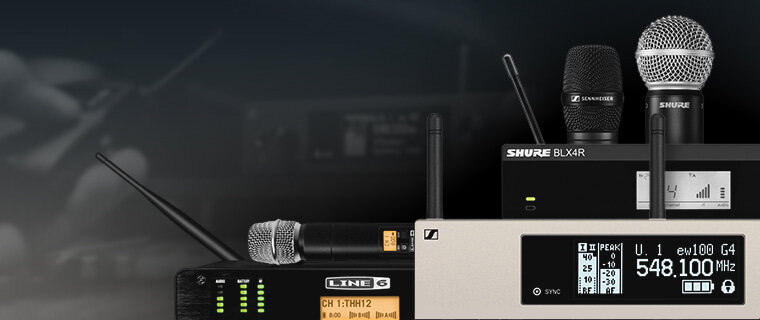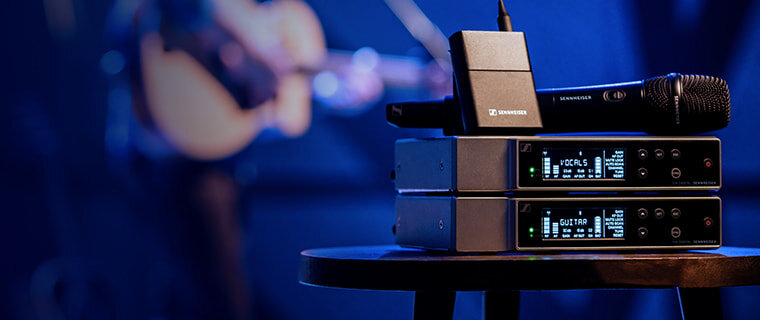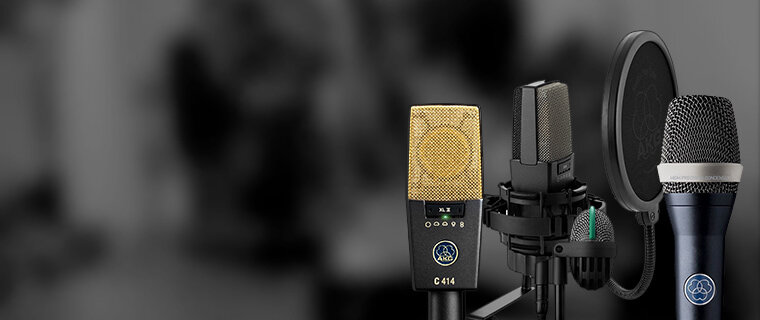Customer Kudos
"zZounds is amazing. In this day and age to have a store that still offers in house no interest payment plans, AND a great selection of gear is pretty amazing. I love these cats!"
March 22, 2024
-

Rode Wireless PRO Dual-Channel Wireless Microphone + Recording System
$399.00
- 8 x$49.88
- No Credit Check6 x$66.50
-

Rode Wireless GO II Dual Compact Wireless Microphone System
$299.00
- 8 x$37.38
- No Credit Check6 x$49.83
-

Shure BLX188/CVL Dual Wireless Lavalier Microphone System
$629.00
- 12 x$52.42
- No Credit Check6 x$104.83
-

Sennheiser EW-D ME 2 Lavalier Set Wireless Microphone System
$699.00
- 12 x$58.25
- No Credit Check6 x$116.50
-
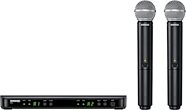
Shure BLX288/SM58 Dual-Channel SM58 Wireless Handheld Microphone System
$649.00
- 12 x$54.08
- No Credit Check6 x$108.17
-

Shure BLX288/PG58 Dual-Channel Handheld Wireless PG58 Microphone System
$549.00
- 8 x$68.63
- No Credit Check6 x$91.50
-
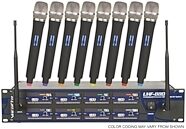
VocoPro UHF-8800 Pack 8-Channel Wireless Microphone System
$599.95
- 12 x$50.00
- No Credit Check6 x$99.99
-

VocoPro UHF-5800 4-Channel Handheld Wireless Microphone System (with Gig Bag)
$399.00
- 8 x$49.88
- No Credit Check6 x$66.50
With a wireless microphone system, performers can move freely on stage, unrestricted by cables. Just like wired microphones, wireless mics are available as both dynamic and condenser varieties, and they come in cardioid, supercardioid, and omnidirectional pickup patterns. For vocals and speech, you have the choice of a handheld, lavalier, or headset/earset wireless microphone. Clip-on wireless mics are also available for woodwind, brass and percussion instruments. But although wireless microphones come in many shapes and sizes, every wireless mic system has three components: the microphone element itself, a transmitter that attaches to the mic, and a receiver which picks up the signal from the transmitter, converts it to audio, and feeds the audio into the sound system.
Handheld wireless microphones integrate the transmitter into their microphone handle. Wireless handhelds are great for lead singers who like to hold the mic, and they're a must-have for events when a "roving" microphone is needed -- such as impromptu toasts at a big dinner, or an audience talkback session after a presentation. Even if your "handheld" mics stay on mic stands and are never actually held in anyone's hand, going wireless can save you time and trouble. For example, if you're working in a venue that needs to be set up, struck, and turned around quickly, using wireless handhelds means no more running and wrapping tons of cables! Plus, without all that cable clutter, wireless mics always look clean and sharp on mic stands -- making them a great choice for houses of worship, formal events, and more. Just like your typical wired vocal microphones, wireless handheld mics are more commonly dynamic mics, but condenser mics are also available. Handheld vocal mics generally use cardioid or supercardioid pickup patterns, although the long-handled wireless handheld mics you see on broadcast TV are likely to be omnidirectional (so they can pick up both the host and the guest.)
Are you an active performer that needs your hands free? If you dance or play an instrument while you sing, a headset wireless microphone is your hands-free solution. Headworn vocal microphones typically have a flexible arm that extends over your ear toward your mouth, with a band that hooks behind your neck and over your ears to hold the mic in place. The smallest, lightest kind of headmic has a single earhook, and is often called an "earset" mic instead of a "headset." Most earset/headset microphone systems include a separate bodypack or beltpack transmitter, about the size of a deck of cards, which fits in your pocket and connects to the mic itself with a slim wire. Some wireless headset microphones need no bodypack: their transmitter is built into the back of the neckband -- ideal for dance/fitness instructors.
Need a small, unobtrusive microphone? Lavalier wireless microphones quickly clip on to the lapel or collar, and they can be cleverly hidden in a performer's hair or clothing -- in fact, some lav mics come in colors designed to blend with your skin or hair. Discreet lavalier mics, sometimes simply called "body mics," are a great fit for stage actors, dancers who sing, worship leaders, corporate presenters -- just about anyone who wants freedom of movement without the look of a large microphone. Wireless lavalier mics are typically the mic of choice for TV presenters and guests; and on film sets, sound mixers often record wireless lav mics hidden in actors' costumes so they're nearly invisible. Most lavalier systems come with the miniature microphone element itself on a long, slim cable, which connects to a bodypack transmitter in the performer or presenter's pocket (or hidden under their clothes).
Vocalists aren't the only performers who use wireless mics. For wind, brass, and percussion players who carry their instruments, a clip-on instrument microphone can plug into a wireless bodypack transmitter, giving musicians freedom to move around and still stay "on mic." These microphones generally clip on to your instrument's bell or rim, with a flexible gooseneck to position the mic.
Handheld vs. lavalier? If you're shopping for a single wireless system, and you're not sure which style of mic/transmitter is best, a combination wireless system is a cost-effective solution. "Combination" systems include 2 or 3 types of transmitters and a single receiver that pairs with any one of the transmitters at a time. For example, a combination wireless system may include one handheld mic, one lavalier mic with a bodypack transmitter, and one receiver. Because both of the mics operate on the same wireless frequency, you'll only be able to use one at a time. This kind of "combination" system is a good choice if you like to have the option of using a handheld mic or lavalier mic -- just not simultaneously.
If you do need to run several wireless microphones at the same time, each microphone must operate on a different wireless frequency so their signals don't interfere with each other. Some wireless systems are fixed-frequency, which means the system always runs on one pre-set frequency. In contrast, a frequency-agile system is tunable to a range of frequencies, making it easier to avoid local TV channels, other wireless users, and other potential sources of interference. This is useful if you'll be using your wireless system in many different venues, near and far. Frequency-agile systems typically have several channels to choose from, which means you can simultaneously run multiple units of the same exact wireless system, as long as they're each tuned to distinct channels -- usually as simple as selecting a channel number on the transmitter and receiver. It's typical for wireless systems to allow 6 to 12 different simultaneous channels. For applications that need more channels of wireless -- like theater shows with a large cast where everyone's wearing a microphone -- you'll need to run systems on multiple frequency bands, and make sure they're not overlapping.
Just want to run two wireless mics simultaneously? The simple solution is to choose a dual-channel wireless system. A "Dual" system comes with two transmitters and a dual-channel receiver that's designed to receive both microphones without interference.
Need help? Our Wireless Microphone Buying Guide covers the basics of wireless transmitters and receivers, VHF vs. UHF, analog vs. digital wireless, and single vs. dual-channel systems. Call our Gear Experts now for help with your purchase: 800-460-8089.
Handheld wireless microphones integrate the transmitter into their microphone handle. Wireless handhelds are great for lead singers who like to hold the mic, and they're a must-have for events when a "roving" microphone is needed -- such as impromptu toasts at a big dinner, or an audience talkback session after a presentation. Even if your "handheld" mics stay on mic stands and are never actually held in anyone's hand, going wireless can save you time and trouble. For example, if you're working in a venue that needs to be set up, struck, and turned around quickly, using wireless handhelds means no more running and wrapping tons of cables! Plus, without all that cable clutter, wireless mics always look clean and sharp on mic stands -- making them a great choice for houses of worship, formal events, and more. Just like your typical wired vocal microphones, wireless handheld mics are more commonly dynamic mics, but condenser mics are also available. Handheld vocal mics generally use cardioid or supercardioid pickup patterns, although the long-handled wireless handheld mics you see on broadcast TV are likely to be omnidirectional (so they can pick up both the host and the guest.)
Are you an active performer that needs your hands free? If you dance or play an instrument while you sing, a headset wireless microphone is your hands-free solution. Headworn vocal microphones typically have a flexible arm that extends over your ear toward your mouth, with a band that hooks behind your neck and over your ears to hold the mic in place. The smallest, lightest kind of headmic has a single earhook, and is often called an "earset" mic instead of a "headset." Most earset/headset microphone systems include a separate bodypack or beltpack transmitter, about the size of a deck of cards, which fits in your pocket and connects to the mic itself with a slim wire. Some wireless headset microphones need no bodypack: their transmitter is built into the back of the neckband -- ideal for dance/fitness instructors.
Need a small, unobtrusive microphone? Lavalier wireless microphones quickly clip on to the lapel or collar, and they can be cleverly hidden in a performer's hair or clothing -- in fact, some lav mics come in colors designed to blend with your skin or hair. Discreet lavalier mics, sometimes simply called "body mics," are a great fit for stage actors, dancers who sing, worship leaders, corporate presenters -- just about anyone who wants freedom of movement without the look of a large microphone. Wireless lavalier mics are typically the mic of choice for TV presenters and guests; and on film sets, sound mixers often record wireless lav mics hidden in actors' costumes so they're nearly invisible. Most lavalier systems come with the miniature microphone element itself on a long, slim cable, which connects to a bodypack transmitter in the performer or presenter's pocket (or hidden under their clothes).
Vocalists aren't the only performers who use wireless mics. For wind, brass, and percussion players who carry their instruments, a clip-on instrument microphone can plug into a wireless bodypack transmitter, giving musicians freedom to move around and still stay "on mic." These microphones generally clip on to your instrument's bell or rim, with a flexible gooseneck to position the mic.
Handheld vs. lavalier? If you're shopping for a single wireless system, and you're not sure which style of mic/transmitter is best, a combination wireless system is a cost-effective solution. "Combination" systems include 2 or 3 types of transmitters and a single receiver that pairs with any one of the transmitters at a time. For example, a combination wireless system may include one handheld mic, one lavalier mic with a bodypack transmitter, and one receiver. Because both of the mics operate on the same wireless frequency, you'll only be able to use one at a time. This kind of "combination" system is a good choice if you like to have the option of using a handheld mic or lavalier mic -- just not simultaneously.
If you do need to run several wireless microphones at the same time, each microphone must operate on a different wireless frequency so their signals don't interfere with each other. Some wireless systems are fixed-frequency, which means the system always runs on one pre-set frequency. In contrast, a frequency-agile system is tunable to a range of frequencies, making it easier to avoid local TV channels, other wireless users, and other potential sources of interference. This is useful if you'll be using your wireless system in many different venues, near and far. Frequency-agile systems typically have several channels to choose from, which means you can simultaneously run multiple units of the same exact wireless system, as long as they're each tuned to distinct channels -- usually as simple as selecting a channel number on the transmitter and receiver. It's typical for wireless systems to allow 6 to 12 different simultaneous channels. For applications that need more channels of wireless -- like theater shows with a large cast where everyone's wearing a microphone -- you'll need to run systems on multiple frequency bands, and make sure they're not overlapping.
Just want to run two wireless mics simultaneously? The simple solution is to choose a dual-channel wireless system. A "Dual" system comes with two transmitters and a dual-channel receiver that's designed to receive both microphones without interference.
Need help? Our Wireless Microphone Buying Guide covers the basics of wireless transmitters and receivers, VHF vs. UHF, analog vs. digital wireless, and single vs. dual-channel systems. Call our Gear Experts now for help with your purchase: 800-460-8089.

